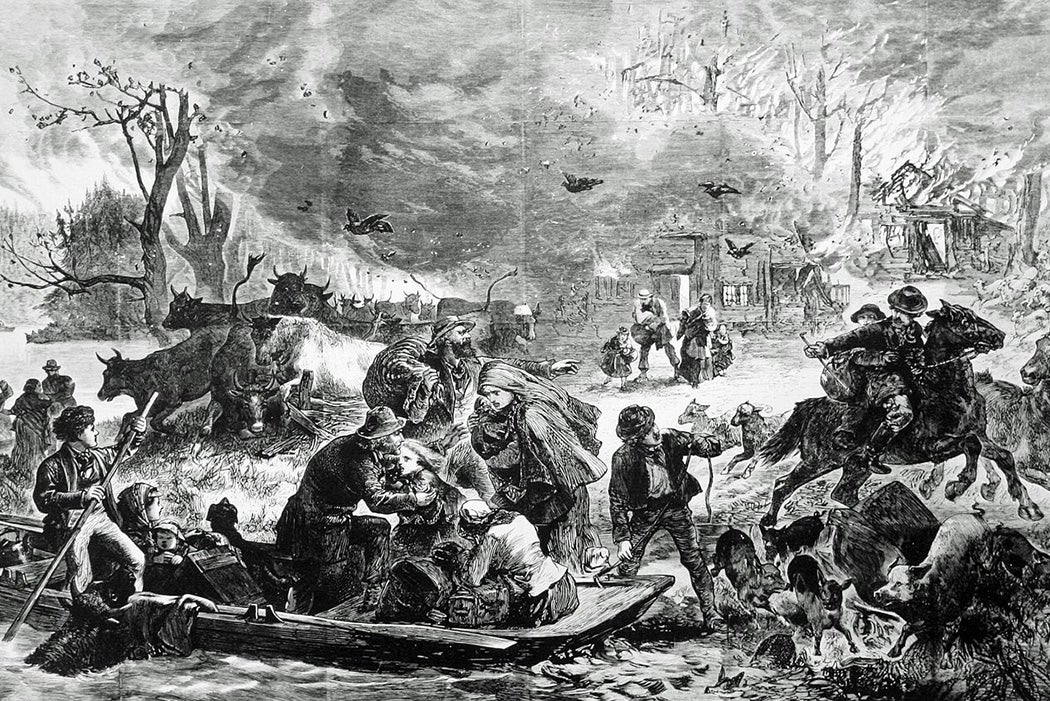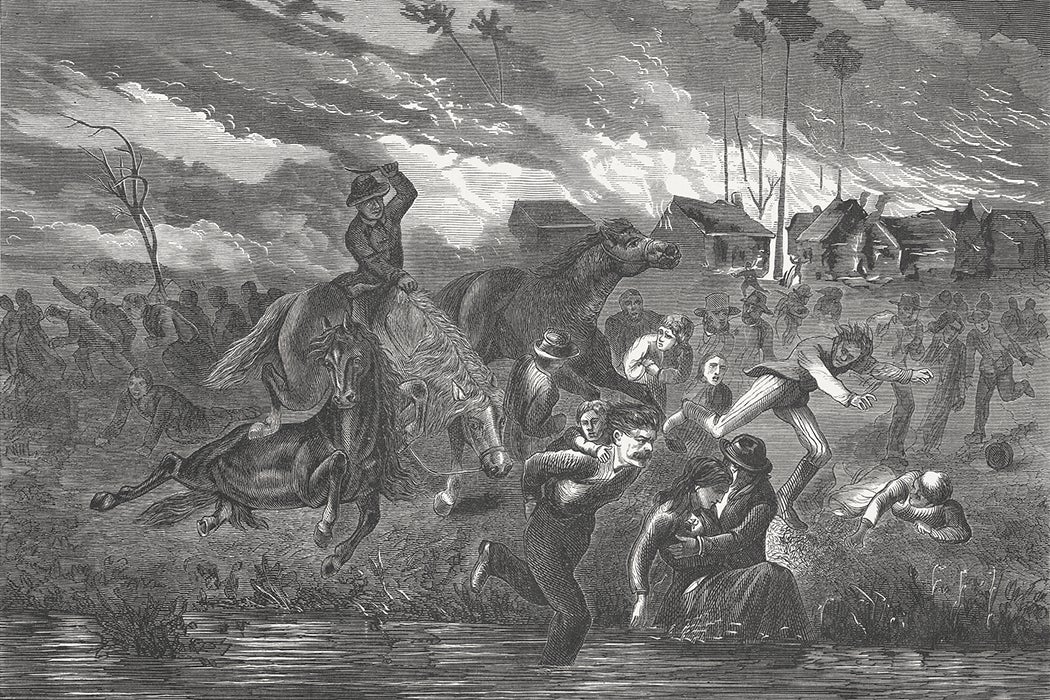On the night of October 8, 1871, more than three square miles of the heart of Chicago burnt down. Around 300 inhabitants lost their lives. The Great Chicago Fire is certainly famous, but it wasn’t the only big fire that night. Two hundred miles north, a firestorm swept through 2,400 square miles of Wisconsin and Michigan and claimed more than 1,100 lives. The Peshtigo Fire, named after the Wisconsin town incinerated in the blaze, remains the nation’s deadliest wildfire.
Because it was a major metropolis, the Great Chicago Fire got all the attention that night and many afterwards. For instance, of the things you almost certainly know about Chicago, Mrs O’Leary’s cow is probably right up there with deep dish pizza. Kate O’Leary’s infamous bovine, named variously Daisy, Madeline, or Gwendolyn, is supposed to have started the fire by kicking over a barn lantern. (There are reasons to suspect the story is bunk.)
The Peshtigo Fire, meanwhile swept through a sparsely inhabited frontier far from the amplifying voice of media. News of the fire didn’t even reach the state capital in Madison until October 10. Wisconsin’s governor was actually in Chicago with relief supplies for that fire, so his twenty-four-year-old wife, Francis Bull Fairchild, began the home-state relief missions, even rerouting a boxcar of supplies bound for Chicago.
In the aftermath, there was only one major publication on the Peshtigo Fire for decades: Green Bay journalist Frank Tilton’s quickly produced Sketch of the Great Fires in Wisconsin at Peshtigo, the Sugar Bush, Menekaune, Williamsonville, and Generally on the Shores of Green Bay: with Thrilling and Truthful Incidents by Eyewitnesses (1871). The volume was sold for the benefit of survivors.
Not included in Tilton’s book was the account written by John Peter Pernin, published in Montreal in French and English versions in 1874. Born in France about 1822 as Jean-Pierre Pernin, Father Pernin was the Catholic priest in the parishes of Peshtigo and nearby Marinette. Both of his churches burnt to the ground.

“Ostensibly [written] to raise funds for a new church in Marinette, Father Pernin’s account may have also been an attempt to exorcise the memories of that October night during which he suffered fearfully while behaving heroically,” noted the editors of The Wisconsin History Magazine.
As the editors wrote on the occasion of the fire’s centennial, no one equaled Pernin’s memoir “in vividness, imagery, or sheer drama.” A century and a half after the fire, it’s still a visceral read, right down to the near-hanging of a man caught robbing corpses after the fire.
According to Pernin, 1871 was “distinguished by its unusual dryness.” Drought plagued much of the country all summer and autumn. There were major fires from the Rockies to the Alleghenies. In the weeks before October 8, the woods around Peshtigo crackled with flames. Fire was in the air, and worried residents were not unprepared: “hogsheads of were water were placed at intervals all around the town, ready for any emergency.”
But what came was no ordinary emergency. Multiple small fires fused into giant fires thanks to fierce winds that Pernin describes as hurricane-like. (The same cyclonic winds drove Chicago’s fire.) Jumping from tree to tree to bush to bush, the fire stormed across the landscape until it came to the wooden buildings of Peshtigo, where it leaped from structure to structure. Hundreds of Peshtigo residents died.
Weekly Newsletter
“Sand, dust, ashes, cinders, sparks, smoke, and fire” made it impossible to breath and impossible to see. The winds were so strong they threw Pernin to the ground repeatedly as he and others ran for the Peshtigo River. They waded in to their chins, splashing water on their heads because the air rained burning material down on them. They were in the water most of the night as what were later described as tornadoes of fire burned land on both sides of Green Bay.
“I came out of the river about half past three in the morning,” wrote Pernin, “and from that time I was in a very different condition, both morally and physically, to that in which I had previously been.”
Temporarily blinded, Pernin soon regained his sight and helped fellow survivors. He lived until 1909. Peshtigo was re-built and now houses a museum dedicated to the fire.







